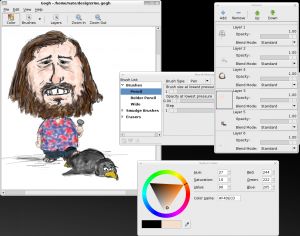Author: Nathan Willis
Gogh is an extremely lightweight drawing program designed for pressure-sensitive devices. Despite its simplicity, it packs in a lot of features and a lot of fun.
You can download Gogh packages from the project’s Web site. The latest release is 0.1.2.1. Gogh is written in Python, and you can uncompress and run the source code tarballs from any place on your system — no compilation or installation step required. You do need to have PyGTK, PyXML, and gnome-python installed. All are run-of-the-mill Python packages, though, so check your distribution’s package management system.
You do not need a pressure-sensitive device like a Wacom tablet to use Gogh, but without one you are far more limited in what you can draw.
The pressure is on
Once you have verified the prerequisites and have downloaded Gogh, simply extract the package and run the app from the command line with ./gogh &.
Up pops the main Gogh window, a blank 400×400-pixel canvas with a few tools and buttons at the top. You can toggle the visibility of three helper windows: the color selector, the brush selector, and the layer manager. The color selector is the standard GTK color selection widget, with a color wheel as well as HSV, RGB, and HTML choosers.
Gogh comes with five brushes predefined: three widths of “pencil,” a smudge brush, and an eraser. The brush selector allows you to tweak the size, opacity, and pressure sensitivity of all, and you can define as many additional custom brushes as you want.
The layer manager allows one-click creation of new layers, plus reordering and control of the opacity and blend mode for each layer.
That is about all you need to know to get started.
Gogh is intentionally simple in its interface, but sports some fancy features. Undos and redos are infinite. You can enlarge, shrink, or expand the canvas as needed. Gogh is even smart enough to bind the eraser brush to the eraser end of your Wacom stylus.
You can save your work in .gogh format, preserving the layers of your document, or export it in flattened form to JPEG or PNG.
Drawing conclusions
Some of the features you think you would miss when coming from a higher-end graphics app you won’t even notice aren’t there. Take layer names, for instance. Most graphics editors allow you to name your layers, but Gogh does not. But since Gogh is designed only with sketching and drawing in mind — and not, say, Web site mockups or photo retouching — the thumbnail views in the layer manager make it easy enough to tell which layer is which.
Nevertheless, there are a few areas with room for improvement. For example, Gogh layers are always transparent, which is good, but when exporting your work to JPEG or PNG, the app always creates a white background. You can add your own multi-colored background as a layer, but you cannot export an image with a transparent background.
And although I know adding additional tools is a slippery slope for an intentionally simple editor like Gogh, there are occasions when I would like some extras — such as selection tools, with which you could cut part of a drawing out in order to move it to another layer.
The only behavior that I would classify as a bug is in saving files. Gogh always wants to save your drawing in the folder from which you launched Gogh. That is a reasonable guess for the very first time, but once you have manually selected a different save folder, the app should remember it for the next time.
Gogh creator Aleksey Nelipa says there is more to come in future releases — including additional tools and more complex control over layers. But he also says that he wants to keep Gogh easy and fun to use, and to keep it pure Python for as long as possible. A longtime user of the proprietary natural-media app Painter, Nelipa undertook creating Gogh as his first foray into Linux and Python development, so developing it is an ongoing learning experience. Nevertheless, he adds, “any ideas, suggestions or feature requests are welcome.”
Gogh obviously can’t take the place of robust, fully fleshed-out image editors like the GIMP, Krita, or Inkscape — all of which also support pressure sensitivity. But there is a place for a small and straightforward app, too. Gogh is fun to draw with, which is what really matters in the end.
Categories:
- Reviews
- Graphics & Multimedia



